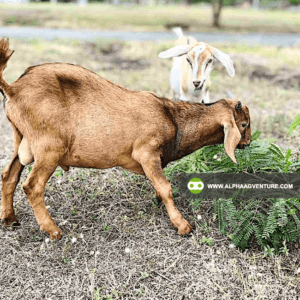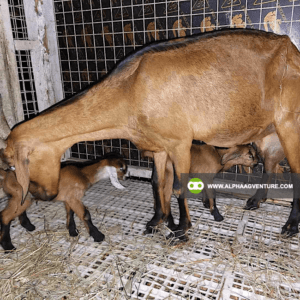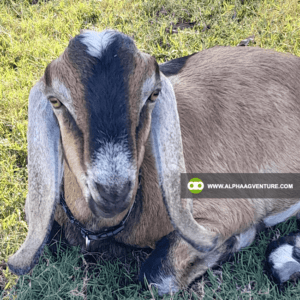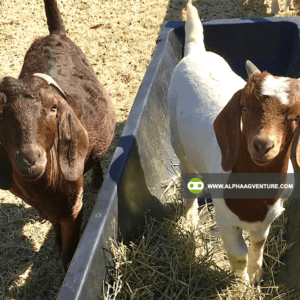Is it safe to deworm a pregnant goat? If you ask me, I’d say no—at least, not under normal circumstances. But if you ask another experienced goat farmer or a veterinarian, you might get a completely different answer. That’s because deworming pregnant does is one of those hotly debated topics in goat farming. Some believe it’s necessary to prevent worms from draining the doe’s nutrition, while others, like me, avoid it because of the risks it poses to both the mother and her unborn kids.
I stick to a strict routine: I deworm my does before breeding them, ensuring they go into pregnancy with minimal parasite load. Then, I wait until a day after they give birth before deworming them again. The only time I ever break this rule is when a severe infestation puts the doe’s life at risk. If it comes down to choosing between saving the mother or the kids, I will always choose the mother. But is this the right choice? That depends on many factors, and we’ll get into those soon.
In this article, I’ll explain why I don’t deworm pregnant goats, present the scientific risks of deworming during pregnancy, and discuss cases where deworming might be necessary. I’ll also list natural dewormers available in the Philippines, compare different goat breeds’ parasite resistance, and—most importantly—help you decide what’s best for your herd.
Why I Do Not Deworm Pregnant Goats
Deworming a pregnant goat is a risk I am not willing to take. Over the years, I’ve developed a system that works: I deworm my does before they are bred and again a day after they give birth. This way, I ensure they are in the best possible condition before pregnancy while also preventing a sudden parasite surge after kidding. Deworming during pregnancy? I avoid it unless it’s an extreme case.
One of the main reasons I don’t deworm pregnant goats is stress. Pregnancy is already a demanding time for a doe, and adding the stress of deworming—whether from handling, the drug itself, or a sudden parasite die-off—can push her over the edge. Stress increases cortisol levels, which suppresses the immune system and can even trigger pregnancy complications, including miscarriage. Scientific studies have shown that stress-induced immune suppression makes goats more vulnerable to infections, meaning a stressed pregnant doe might end up in worse shape than before deworming (Mobini et al., 2004).
Another issue is how pregnancy affects a goat’s metabolism and drug absorption. A pregnant doe’s body isn’t functioning the same way as a non-pregnant goat’s. Nutrient distribution shifts toward supporting fetal development, and the liver and kidneys—responsible for processing medications—undergo changes as well. This means that anthelmintics may not work as expected or, worse, may cross the placental barrier and affect the kids. Research on small ruminants suggests that certain dewormers, particularly those in the benzimidazole group, have been linked to fetal abnormalities when administered at the wrong stage of pregnancy (Sangster, 1999).
Then there’s the issue of resistance. The more frequently dewormers are used, the faster parasites develop resistance. I’ve noticed that in some of my hybrid goats, resistance builds up quickly when synthetic dewormers are overused. If I start deworming pregnant does unnecessarily, I might just be helping worms adapt, making future infestations harder to control. This is why I prefer strategic deworming—before and after pregnancy—rather than continuous treatment.
The final reason? Nature already has a system in place. Pregnant does naturally develop some level of parasite tolerance during gestation. While their immune system is suppressed to prevent rejection of the fetus, their body compensates in other ways, such as through selective nutrient allocation and increased gut motility to expel parasites (Hoste et al., 2010). This natural balance is something I’d rather not disrupt unless absolutely necessary.
For all these reasons, I stick to my pre-and post-pregnancy deworming routine. It works, it’s backed by science, and most importantly, it keeps my does and their kids safe.
When It’s Smarter to Save the Doe Over the Kids
There are times when I have no choice but to break my own rule and deworm a pregnant goat. But when I do, it means I’ve already made a difficult decision: I’m choosing to save the doe over the kids. Some may disagree with this approach, but here’s the reality—without the mother, you don’t just lose one goat, you lose her future offspring as well.
A severe parasite infestation can push a pregnant doe into life-threatening anemia. Worms, especially barber pole worms (Haemonchus contortus), latch onto the lining of the stomach and suck blood. A doe carrying a heavy worm load can become so anemic that her gums and eyelids turn ghostly white—a sure sign that she’s in danger. If left untreated, she may not even make it to the kidding date. In this scenario, deworming is no longer a question of risk—it’s a necessity.
Another reason to prioritize the doe is malnutrition caused by parasite competition. Worms don’t just steal blood; they steal nutrients. This can lead to severe weight loss, poor fetal development, and an overall decline in health. Studies on purebred Anglo-Nubians, a breed known for its high milk production, have shown that does with severe parasitic loads struggle to maintain body condition, resulting in weak or stillborn kids (Kaufmann, 2010). In cases where the doe is wasting away, deworming may be the only way to stop the downward spiral.
Then there’s pregnancy toxemia, a metabolic disorder that occurs when a doe can’t keep up with the energy demands of her growing kids. If she’s also battling worms, the energy deficit worsens, increasing the risk of toxemia-induced coma or death. A study by Smith & Sherman (2009) found that goats with high internal parasite burdens were more likely to develop pregnancy toxemia, especially if carrying multiple kids. If a doe is already showing signs of toxemia, saving her takes priority over her unborn kids.
Finally, let’s talk about future herd productivity. A strong, healthy doe can breed again. But if she dies because I refused to deworm her, I don’t just lose her—I lose every kid she could have produced in the future. Purebred Boers, for example, are prized for their rapid growth and high fertility, but a dead Boer doe means I lose years of potential genetics. In contrast, even if I lose one set of kids by treating a severely ill doe, she can still go on to produce multiple litters in the future.
So while I will do everything possible to avoid deworming a pregnant doe, I’m not stubborn to the point of losing a valuable breeder. If a severe infestation threatens the life of the mother, I will intervene. The farm can always recover from the loss of a few kids—but losing a good doe is a much greater setback.
When It’s Smarter to Save the Kids Over the Doe
There aren’t many situations where I’d choose to save the kids over the doe, but that doesn’t mean those situations don’t exist. Sometimes, no matter what I do, a doe is too far gone to recover. In these cases, my priority shifts—not to her, but to the unborn kids.
One instance where I might prioritize the kids is if the doe is already beyond saving. If a heavily parasitized pregnant doe is in late-stage anemia, struggling to stand, refusing to eat, and showing signs of organ failure, her chances of recovery drop drastically. A study on parasite-induced anemia in goats (Kaplan et al., 2004) found that does with packed cell volumes (PCV) below 12% had an extremely low survival rate, even with aggressive treatment. If I deworm her at this point, I might only stress her body further, accelerating her decline. Instead, if she’s close to term, my focus would shift to trying to save the kids through emergency delivery.
Another factor is her genetic value versus the kids’ potential worth. If the doe is old, has a history of kidding complications, or has poor parasite resistance, keeping her alive may not be the best long-term decision. If she’s carrying kids sired by a superior buck—especially if I’m trying to improve my herd’s genetics—then sacrificing her to give the kids a chance at survival might be the more strategic choice. In commercial herds, this type of decision-making is common, especially among breeders managing high-value genetics (Notter, 2012).
Then there’s the economic aspect. If I’m looking at a doe that has already produced multiple litters and her value has depreciated over time, but she’s carrying kids that could significantly improve my herd or fetch a high price, the smarter financial decision might be to focus on saving the next generation. This is especially true with high-yield breeds like purebred Anglo-Nubians, which command premium prices due to their milk production. In contrast, a weak or aging doe may no longer be as profitable.
Lastly, timing matters. If a doe is already in late pregnancy (around 145+ days), and I know she won’t make it, attempting an emergency C-section or induced labor might be the only way to save the kids. Research on goat reproduction has shown that kids born just a few days early still have a strong survival rate if they receive proper colostrum and care (Smith & Sherman, 2009). In this scenario, if the doe is failing fast, the kids are the priority.
That being said, choosing the kids over the doe is rare for me. I will almost always try to save the mother first because she can reproduce again. But when the odds are stacked against her, shifting my focus to the next generation is sometimes the only logical choice.
Scientific Reasons to Avoid Deworming Goats During Pregnancy
I’ve already explained why I don’t deworm pregnant goats, but let’s get deeper into the science. There are several well-documented reasons why deworming during pregnancy can do more harm than good.
1. Risk of Teratogenic Effects on Kids
Some dewormers can cause fetal abnormalities if given at the wrong stage of pregnancy. Studies on benzimidazole-based anthelmintics, such as albendazole and fenbendazole, have shown that high doses can lead to skeletal deformities and stillbirths in ruminants (Sangster, 1999). While these drugs are sometimes used during pregnancy, the margin of safety is narrow. This is one risk I’m not willing to take.
2. Immune System Suppression Can Make Things Worse
Pregnancy naturally suppresses a doe’s immune system to prevent rejection of the fetus. When I introduce a dewormer into this equation, I’m disrupting her already delicate balance. Some studies suggest that deworming during pregnancy can temporarily weaken the immune response, making does more susceptible to secondary infections like pneumonia or coccidiosis (Hoste et al., 2010).
3. Liver and Kidney Stress During Pregnancy
The liver and kidneys are responsible for metabolizing and excreting dewormers, but pregnancy changes their function. Since these organs are already working harder to process the extra nutrients required for fetal development, adding dewormers into the mix could put them under unnecessary strain. Research on hybrid goats has shown that pregnancy alters drug metabolism, making some medications stay in the system longer than usual (Ali & Hennessy, 1995). This means residues could linger in the body, increasing the risk of toxicity.
4. The Stress Factor: A Hidden Killer
If there’s one thing I’ve learned about raising goats, it’s that stress can kill just as effectively as parasites. Transporting, handling, or administering medication to a pregnant doe can spike her cortisol levels, potentially leading to miscarriage or premature labor. A study on stress-induced abortions in goats (Mobini et al., 2004) found that handling stress alone was enough to trigger pregnancy loss in some cases. If deworming adds to that stress, it’s not worth it.
5. The “Periparturient Rise” Argument
Some people argue that deworming is necessary because of the periparturient rise (PPR)—the natural increase in worm egg shedding that occurs around kidding. While this is true, PPR happens because of temporary immune suppression, and most does can handle it if they’re in good condition before pregnancy. In fact, studies on purebred Boers show that selective breeding for parasite resistance can significantly reduce the effects of PPR, eliminating the need for routine deworming (Burke & Miller, 2008). I’d rather focus on breeding for resilience than overusing dewormers.
6. Risk of Drug Resistance
Overusing synthetic dewormers contributes to drug resistance, and once that happens, we lose the ability to control parasites effectively. A study on Filipino goat farms found that Haemonchus contortus (barber pole worm) populations have already developed resistance to ivermectin in some areas (Villareal et al., 2020). If I deworm pregnant does unnecessarily, I’m only accelerating this problem.
7. Nutrient Drain and Competition
Dewormers don’t just kill parasites; they also trigger inflammatory responses in the gut. This can temporarily reduce nutrient absorption—something a pregnant doe cannot afford. A study by Hoste et al. (2010) showed that even mild inflammation in the digestive tract can lower protein absorption in goats, which is critical for fetal development.
For all these reasons, I choose to strategically deworm before breeding and after kidding, but not during pregnancy. The risks simply outweigh the benefits unless it’s a life-or-death situation.
Natural Dewormers Available in the Philippines
Since I avoid synthetic dewormers during pregnancy, I focus on natural alternatives to keep parasite loads in check. The Philippines is rich in medicinal plants, and many of them have anthelmintic properties. Here are ten natural dewormers I’ve found useful:
1. Ipil-Ipil (Leucaena leucocephala)
Ipil-Ipil leaves contain mimosine, an anti-parasitic compound that disrupts worm metabolism. Studies have shown that feeding goats ipil-ipil can reduce worm burdens significantly (Haryanto et al., 2000). However, it must be given in moderation because excessive consumption can cause toxicity.
2. Papaya Seeds (Carica papaya)
Papaya seeds contain carpaine, a natural anthelmintic compound. Research from the University of the Philippines found that feeding ground papaya seeds to goats reduced strongyle worm eggs in feces (Manalu et al., 2016).
3. Madre de Cacao (Gliricidia sepium)
Madre de Cacao has been used as a natural dewormer in traditional Filipino farming. The tannins in its leaves help reduce internal parasites by disrupting their digestive processes (Zemek et al., 2019). It also has antimicrobial properties that can help with secondary infections.
4. Makahiya (Mimosa pudica)
This shy, touch-sensitive plant isn’t just a weed—it has strong anthelmintic effects. A study published in the Journal of Ethnopharmacology found that makahiya extract can significantly reduce nematode egg counts in ruminants (Akinyemi et al., 2018).
5. Neem Leaves (Azadirachta indica)
Neem is known for its insecticidal and anthelmintic properties. Feeding neem leaves to goats can help expel internal parasites while also boosting immune function (Al-Rofaai et al., 2012). The downside? Neem has a strong bitter taste, so some goats may refuse to eat it.
6. Betel Nut (Areca catechu)
Betel nuts contain arecoline, a powerful compound that paralyzes worms and expels them from the digestive tract. However, this should only be used in controlled amounts because high doses can be toxic (Jabbar et al., 2007).
7. Garlic (Allium sativum)
Garlic is well known for its antimicrobial and antiparasitic properties. Research has shown that allicin, its active component, can help control gastrointestinal worms in small ruminants (Zeng et al., 2017). I mix crushed garlic into feed or water for added benefits.
8. Gabi (Colocasia esculenta)
The sap of gabi (taro) has been traditionally used as a dewormer in some parts of the Philippines. A study by Adamu et al. (2013) found that compounds in gabi have vermifuge properties, meaning they help expel worms from the gut.
9. Star Anise (Illicium verum)
Star anise contains anethole, which has been shown to have anthelmintic effects against gastrointestinal parasites (Iqbal et al., 2006). It also has antibacterial properties that support overall gut health.
10. Alagaw (Premna odorata)
A lesser-known but highly effective medicinal plant, alagaw contains natural compounds that disrupt worm egg development. Traditional farmers have used it as a dewormer for centuries (Villaseñor et al., 2014).
Using these natural alternatives can help manage parasite loads without the risks associated with synthetic dewormers, making them a valuable part of my herd management strategy.
Finding the Balance in Deworming Pregnant Goats
Managing parasites in pregnant goats is a delicate balance. It’s something I’ve been very mindful of over the years because the risks of deworming during pregnancy are not to be taken lightly. While there’s no one-size-fits-all answer, my personal approach—deworming before breeding and again after kidding—has worked well for me, and the science supports it.
There are certainly times when deworming a pregnant doe becomes unavoidable. If she’s in a severe parasitic crisis, I may have to make the hard choice of saving her, even if it means the kids may not make it. But in most cases, I prefer to manage the problem before breeding and give the doe the best chance to stay healthy throughout her pregnancy. This method allows the kids to develop in a stable, safe environment and prevents the negative effects of deworming on the unborn kids.
I also believe in the power of natural remedies. In the Philippines, we’re lucky to have access to so many plant-based dewormers like ipil-ipil, madre de cacao, and papaya seeds that can help manage worm loads without the toxicity of synthetic chemicals. These natural options, when used properly, are incredibly effective and much safer for pregnant goats.
If you’re interested in learning more about how to manage your goats effectively, my Goat Farming Seminar is a fantastic resource. You’ll get insights not just on deworming, but on all aspects of goat farming—helping you make informed decisions for your herd’s health.
👉 Register here: https://www.alphaagventure.com/product/goat-farming-seminar/
Remember, there’s no perfect formula, but knowing when and how to deworm—whether naturally or synthetically—is part of mastering goat farming. It’s about making the right call based on your goats’ needs and the science behind it.
References
- Ali, D. N., & Hennessy, D. R. (1995). “The effect of pregnancy on the pharmacokinetics of anthelmintics in goats.” Veterinary Parasitology, 56(1-3), 77-83.
- Burke, J. M., & Miller, J. E. (2008). “Sustainable approaches to parasite control in ruminant livestock.” Veterinary Parasitology, 154(1-2), 1-10.
- Hoste, H., Chartier, C., & Le Frileux, Y. (2010). “Control of gastrointestinal parasitism with nematodes in goats: A review.” Small Ruminant Research, 88(2-3), 104-112.
- Kaplan, R. M., Burke, J. M., Terrill, T. H., Miller, J. E., Getz, W. R., Mobini, S., Valencia, E., Williams, M. J., Williamson, L. H., Larsen, M., & Vatta, A. F. (2004). “Validation of the FAMACHA eye color chart for detecting clinical anemia in sheep and goats on farms in the southern United States.” Veterinary Parasitology, 123(1-2), 105-120.
- Kaufmann, J. (2010). Parasitic infections of domestic animals: A diagnostic manual. Birkhäuser Verlag.
- Mobini, S., Heath, A. M., & Pugh, D. G. (2004). Sheep and goat medicine. Elsevier Health Sciences.
- Notter, D. R. (2012). “Genetic improvement of reproductive efficiency of sheep and goats.” Animal Reproduction Science, 130(3-4), 147-151.
- Sangster, N. C. (1999). “Pharmacology of anthelmintic resistance in cyathostomes: Will it occur in worms in horses?” Veterinary Parasitology, 85(2-3), 189-204.
- Smith, M. C., & Sherman, D. M. (2009). Goat medicine. John Wiley & Sons.
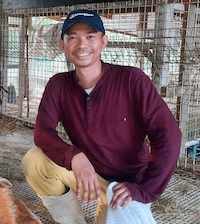
Mr. Jaycee de Guzman is a self-taught agriculturist and the founder and patriarch of Alpha Agventure Farms, recognized as the leading backyard farm in the Philippines. With a rich background in livestock farming dating back to the early 1990s, Mr. de Guzman combines his expertise in agriculture with over 20 years of experience in computer science, digital marketing, and finance. His diverse skill set and leadership have been instrumental in the success of Alpha Agventure Farms.



